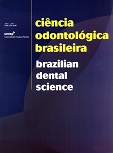Photoinactivation of Escherichia coli using xanthene dyes and light-emitting diodes
DOI:
https://doi.org/10.14295/bds.2009.v12i4.636Resumo
The development of antibiotic resistance by pathogenic bacteria is currently one of the major problems in medicine. Therefore, the study of new treatment modalities such as photodynamic therapy is important. The aim was to evaluate the effects of the Rose Bengal and erythrosine dye combined with a light-emitting diode (LED) on Escherichia coli. An E. coli suspension was prepared from a clinical strain and subjected to the following treatments: LED and Rose Bengal, LED and erythrosin, LED and physiological solution, and physiological solution only as control, and exposure to light for 60, 120 and 180 seconds. After incubation at 37°C for 24 h, the number of colony-forming units (CFU) was calculated and submitted to analysis of variance (ANOVA). Photodynamic therapy using Rose Bengal resulted in a reduction of 5.58 log10 in the number of CFU/mL after light exposure for 60 s and complete elimination after 180 s. However, photodynamic therapy using erythrosin only caused a slight reduction in the number of CFU/ml (0.30 log10) compared to the control group. The use of the LED alone had no toxic effect on the strain tested. In conclusion, Rose Bengal was more effective than erythrosin in photodynamic therapy against E. coli.
Downloads
Downloads
Publicado
Como Citar
Edição
Seção
Licença
TRANSFERÊNCIA DE DIREITOS AUTORAIS E DECLARAÇÃO DE RESPONSABILIDADE
Toda a propriedade de direitos autorais do artigo "____________________________________________________________________" é transferido do autor(es) para a CIÊNCIA ODONTOLÓGICA BRASILEIRA, no caso do trabalho ser publicado. O artigo não foi publicado em outro lugar e não foi submetido simultaneamente para publicação em outra revista.
Vimos por meio deste, atestar que trabalho é original e não apresenta dados manipulados, fraude ou plágio. Fizemos contribuição científica significativa para o estudo e estamos cientes dos dados apresentados e de acordo com a versão final do artigo. Assumimos total responsabilidade pelos aspectos éticos do estudo.
Este texto deve ser impresso e assinado por todos os autores. A versão digitalizada deverá ser apresentada como arquivo suplementar durante o processo de submissão.




























